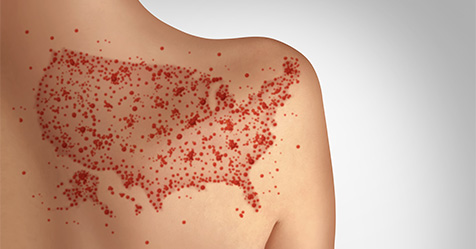Maintaining a clean, healthy, and visually appealing landscape is more than an aesthetic consideration for commercial properties; it’s a strategic investment in brand reputation, property value, and safety. A well-kept exterior signals professionalism, leaves a positive impression on clients and visitors, supports tenant retention, and boosts employee morale. However, achieving this level of consistent curb appeal requires more than occasional mowing or seasonal touch-ups. It demands a comprehensive, seasonally focused grounds maintenance plan that addresses both landscape health and pest control throughout the year.
Landscape and irrigation tips
Effective maintenance begins with smart design. When selecting plants, prioritize not just appearance but also pest resistance, cleanliness, and water usage. Plants and trees that shed excessive leaves or debris can increase the need for cleanup and attract pests. Choose species that are less prone to infestations to reduce reliance on pest treatments and frequent maintenance.
Equally important is the principle of “right plant, right place.” Position plants to support healthy growth, with access to adequate sunlight, air circulation, and enough room for root expansion. Place vegetation far enough from the structure to prevent moisture issues and pest access points. Consider long-term growth patterns to avoid blocked lines of sight or safety blind spots.
Irrigation design adds another layer of complexity. Water delivery must be uniform, but drainage is equally critical. Poor drainage can cause pooling, root rot, and increased pest pressure. Segment irrigation into shorter, timed intervals to allow water to soak in gradually, minimizing runoff and the amount of water needed to maintain a healthy landscape. Take care to avoid water accumulation in unintended areas such as sidewalks, entrances, and building foundations, where it can create slip hazards or contribute to wood decay and termite activity. Set irrigation schedules to avoid high-traffic times, reducing disruption to employees and guests.
Seasonal maintenance schedules
Each season presents unique challenges and opportunities for landscape care. Grass, shrubs, trees, and pests all respond differently to shifts in temperature, moisture, and sunlight. Ignoring these seasonal dynamics can result in turf damage, stressed plants, and pest infestations—issues that can quickly become costly. A proactive, year-round maintenance approach ensures that your landscape is nurtured according to its seasonal needs and that potential problems are addressed before they escalate.
Fall: Fortify and clean up: Fall presents the opportunity to repair summer wear and prepare the property for winter dormancy. Apply a final round of fertilizer to help strengthen root systems
and enable turf to store nutrients. Conduct soil tests and adjust pH levels or nutrient balances ahead of spring.
Focus pest management efforts on preventing rodent intrusion, as cooler temperatures may drive them indoors. Seal exterior entry points and install bait stations to reduce the risk.
Winter: Monitor and plan ahead: Although vegetation growth slows in winter, it is not a time for landscape neglect. Winter presents an ideal opportunity to monitor site conditions and
perform preventive tasks in preparation for the spring and summer growing seasons.
Minimize foot and vehicle traffic on frozen turf to avoid compaction and physical damage. Continue tree and shrub care with winter pruning of dormant plants, which promotes healthy spring growth and removes hazardous limbs.
Prioritize interior pest monitoring, especially in storage areas, basements, and break rooms where pests may migrate for warmth. Review the past year’s pest activity to refine future maintenance
strategies and identify new areas of concern.
Spring: Renew and prepare: Spring marks a period of growth and renewal, making it essential to give your landscape the boost it needs after winter dormancy. Core aeration helps relieve
compacted soil, improving water and nutrient intake. Apply a balanced, slow-release fertilizer to stimulate healthy plant growth, along with a pre-emergent herbicide to prevent weeds from taking
root and competing with turf and ornamental plantings.
On the pest control front, spring is the ideal time for preventive treatments. Rising temperatures awaken ants, chinch bugs, and other lawn-damaging insects, so early applications can help avert infestations. Promptly address standing water left behind by spring rains to reduce mosquito breeding sites before summer heat amplifies the problem.
Summer: Sustain and protect: Summer brings vibrant landscape colors but also high temperatures, increased foot traffic, and the risk of drought stress. Managing irrigation becomes
critical—be sure to calibrate systems to deliver water efficiently, ideally in the early morning, to reduce evaporation. Mowing practices also matter; maintaining optimal blade height can help turf retain moisture and develop a deeper root system. Spot-treat any emerging problem areas with insecticides or fungicides to prevent widespread damage.
Summer pest control hinges on regular monitoring. Look for early signs of turf damage, insect activity, or nests. Apply exterior barrier treatments around the perimeter of buildings to keep ants, cockroaches, and other pests from finding their way indoors.
Professional partnerships
Creating and executing a seasonally responsive maintenance plan is a multifaceted task—particularly for large or multi-location commercial properties. Partnering with experienced lawn and pest management professionals ensures each seasonal task is completed efficiently, using the most up-to-date methods and environmentally conscious products.
A qualified service partner can develop a customized, cost-effective program tailored to your property’s specific needs and local climate. In addition to improving your outdoor maintenance results, professional management can prevent costly emergency interventions and extend the life of your landscape assets.
By investing in a well-rounded, year-long grounds maintenance strategy, commercial facility managers can protect their properties, enhance curb appeal, and foster a healthier, safer environment for their building tenants and visitors.




